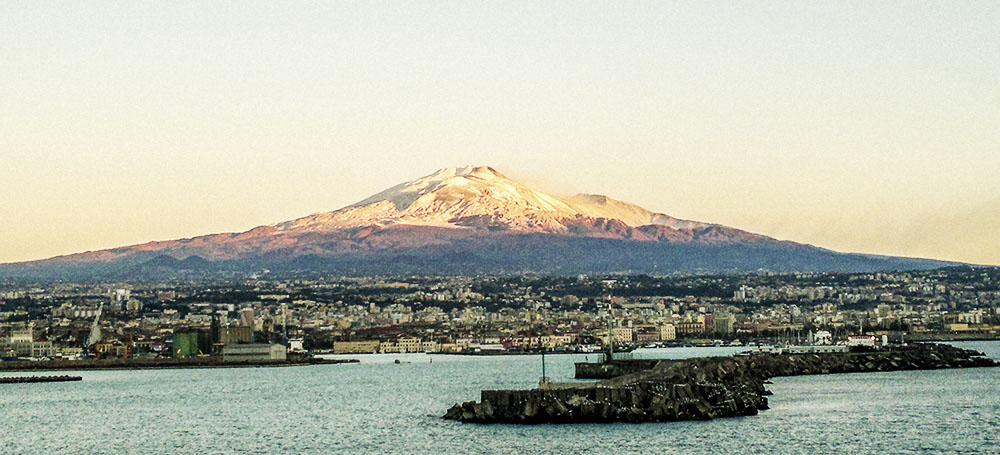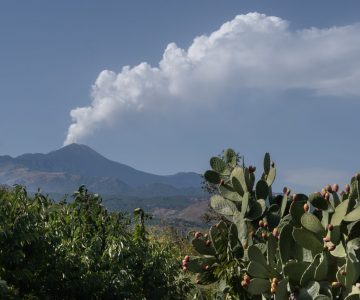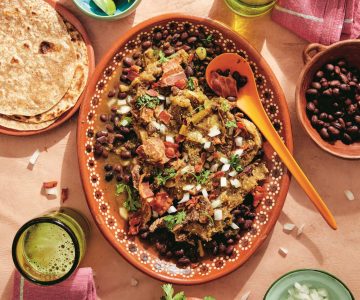
Before heading to the annual Sicilia en Primeur tasting in Palermo, I was reflecting on the main factors that have contributed to the rise of Sicilian wine globally, and came up with the following.
First, the wine world currently has a predilection towards indigenous varietals. With over one million wine brands worldwide based on notables such as Pinot Grigio, Chardonnay, Cabernet and Syrah, people are looking for something different. Second, unwooded, high-acid wines are in fashion. Third, most Sicilian wines are certified organic. Last, Etna, which has become a global phenomenon, is on most sommeliers’ Top 10 list.
On my first visit to the island last year, I decided the signature reds, Nerello (Etna) and Nero d’Avola would be my focus. Why? Two reasons. With its warm Mediterranean climate, the reds relish the heat — it’s these darker renditions that we see in our market.
Well, imagine my surprise when I found out that the island produces 65 percent Sicilian white wine with elevated acids. Altitude (up to 3,000 feet) and strong winds are the two main elements that act as a counterbalance to the heat.
Also, Sicilians themselves drink more white wine because of its refreshing qualities (think lemonade on a hot summer’s day) and because it goes well with their main dietary protein of seafood.
Today, there are 76 authorized grapes, with many more still being discovered. The following are the most notable Sicilian white wines.
Marsala
Sicily’s first wine is Marsala. Production occurs in and around the town of the same name, located in western Sicily. That said, before any grapes were ever vinified, it was a trading port. This is what attracted English wine merchant John Woodhouse back in 1773 when he was looking for a fortified wine that could withstand the rigours of boat travel to England. Once Marsala hit the Queen’s shores, it became an instant success. By the middle of the 1800s, its reputation was on par with that of Port, Madeira and Sherry. Unfortunately, all good things must come to an end. In the 1900s, producers started to make inferior flavoured/sweetened Marsalas, which had nothing to do with quality and everything to do with American Italian veal and chicken dishes. Reputation became so low globally that most producers started to look towards dry white winemaking with the classic varietals of the region (Grillo, Inzolia and Catarratto), which can all produce delightful expressions. It is also worthy to mention that Marsala producers have now re-grouped and started a campaign to promote the virtues of premium dry and sweet Marsala — and there are some exceptional wines that can be had for a song.
Grillo
My favourite Sicilian white wine varietal is Grillo. This crossing of Zibbibo and Catarratto was first created in 1874 to produce a more aromatic Marsala. Other notable attributes include lower yields than other Sicilian varietals, which is always good for quality, and resistantance to heat and drought conditions. Today, there are two main sub-varieties: Nuovo and Vecchio. Vecchio is the original incarnation and is the one that produces more honeyed/richer/fruitier versions. Nuovo, the new bio-type, leans towards the Sauvignon Blanc paradigm with a green/herbaceous edge. With such an array of flavours, many producers state that a mix of both clones in the vineyards produces the complete wine. It is also noteworthy to mention that Grillo sales within Italy increased 23 percent last year, which speaks well to this grape’s future.
Grecanico (Dorato)
Recent DNA testing has shown that this grape is identical to Garganega from Veneto. Basic versions can lack punch. Better versions feature peach, pineapple, honey, pear and bitter almond qualities.
Zibibbo of Pantelleria
The first thing every wine textbook references about the volcanic island of Pantelleria is its proximity to Northern Africa rather than Sicily itself. What the texts don’t mention is the raw beauty of this isolated island of 5,000 inhabitants. Tourists have yet and to discover it because rugged cliffs create its perimeter, rather than sandy beaches, making other Mediterranean islands more attractive to sun lovers.
Pantelleria means “island of the wind,” and after spending two days on the island, this is no hyperbole. That is why the island’s main grape, Zibbibo (aka, Muscat of Alexandria), is grown goblet style to ensure proximity to the soil and to allow the wind to pass over. So unique is the viticulture here that it was granted UNESCO World Heritage status last year.
Even though the majority of Zibbibo grown is used to make the more famous sweet dessert wines, which my colleague Michaela Morris will expand upon in her column, there has been a rise in dry wine production. Look for Muscat’s quintessential call signs of orange blossom, honey, lemon, peach and spice in these renditions. What is even more heartening is the high acidity, which is not the case for most Mediterranean Muscat.
I would also be remiss if I did not mention the other famous agricultural product of the island: capers. Here, they are planted on rocks terraces, next to Zibbibo, picked, brined and then packed in salt for sale.
Catarratto
This, the third Marsala grape, is a parent to Grillo and also to Garganega, the grape of Soave from Northern Italy. The most prolific of all of Sicily’s grapes, Catarratto accounts for 35 percent of all plantings, with the majority situated in the western provinces of Trapani, Palermo and Agrigento. It is also found on Mt. Etna where it is blended with Carricante. People tend to dismiss this varietal as years of over cropping have created a negative impression. When done well, there is a floral attribute that couples with lemon, melon, green apple, white peach and herbal elements. The acid is zippy, and there is a strong mineral backbone.
Carricante
The name of this grape translates as “to load or burden,” a reference to its high yields. Plantings are confined to its home base on Mt. Etna, at elevations exceeding 950 metres. These wines contain serious acidity, which is somewhat tamed by malolactic fermentation. Though there are mono-varietal Carricantes, most of the time it is blended, acting as the dominant grape alongside Catarratto. Etna Bianco DOC must contain a minimum of 60 percent of Carricante, and Etna Bianco Superiore DOC must contain 80 percent. In the mouth, these wines possess a distinct salinity, low alcohol and a savoury/herbal/citrus edge. Fuller versions, which are picked later, have nuances of honey and creaminess from sur lie treatments.
Ins(z)olia
This grape has been cultivated on the island since ancient times. It is respected for its aromas, which run along the lines of peach, pear, apple and almonds, all supported by moderate acidity. Most renditions are mono-varietal, but it also plays nicely with other indigenous and French grapes.
The Future
There are also limited plantings of Malvasia delle Lipari, Fiano, Trebbiano and Pinot Grigio. Of course, Sicily has also succumbed to global tastes, so there are the mandatory plantings of Chardonnay, Sauvignon Blanc and Viognier. More singular options include Chenin Blanc and Müller-Thurgau. Personally, I believe the island should stick to its indigenous heritage, as it is what it does best.
With the 2017 vintage, Sicily doubled its production from the previous year. (Yes, I said doubled!) In the past decade, there have been massive plantings all over the island, and now that they have matured, it is helping to position Sicily as a potent player within Italy and abroad. By way of comparison, the island now has three times the amount of vineyard space than New Zealand and the same as Germany and South Africa. With such a proliferation, it is my fervent hope that we will see more Sicilian white wine on our shores as the prices are reasonable and the quality has never been better.





